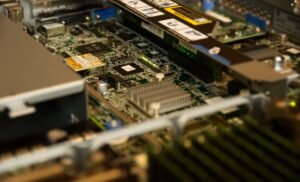Tesla Model S: No Sound
The Tesla Model S is an electric car known for its sleek design, high performance, and numerous technological features. One of the unique attributes of the Model S is its lack of sound – it operates almost silently, unlike traditional internal combustion engine vehicles. This article explores the reason behind the quietness of the Model S and its implications.
Key Takeaways:
- The Tesla Model S stands out for its exceptional quietness on the road.
- This silence is a result of its electric powertrain design and absence of engine noise.
- The “no sound” feature of the Model S offers an enhanced driving experience and reduced noise pollution.
One of the primary reasons for the silence of the Tesla Model S is its electric powertrain system, which differs from the traditional internal combustion engine found in most vehicles. Instead of a noisy engine, the Model S is powered by an electric motor that runs almost silently. This absence of engine noise provides a serene and peaceful driving experience, allowing passengers to enjoy the journey without the usual distractions of a loud engine.
*The quietness of the Model S is often likened to gliding through the road, undisturbed by the typical mechanical sounds associated with car travel.*
Moreover, the lack of engine noise also has environmental benefits. Noise pollution is a growing concern in many urban areas, and vehicles are one of the major contributors to this problem. By eliminating engine noise, the Tesla Model S helps to reduce noise pollution, making our cities quieter and more pleasant places to live.
The Sound of Silence: How It Works
Below is a table that highlights the key components responsible for the quiet operation of the Tesla Model S:
| Component | Description |
|---|---|
| Battery Pack | A large lithium-ion battery used to store and provide power to the vehicle’s electric motor. |
| Electric Motor | A device that converts electrical energy into mechanical energy to propel the car forward without noise. |
| Inverter | A component that converts direct current (DC) power from the battery pack into alternating current (AC) power to run the electric motor efficiently. |
*The electric motor in the Model S is so stealthy that it’s hard to even notice the car is running unless you look for other signs of motion.*
In addition to its quiet operation, the Tesla Model S offers various features that contribute to its overall driving experience. Some notable features include:
- Regenerative braking system that allows the car to recharge its battery when decelerating.
- Advanced Autopilot capabilities for semi-autonomous driving.
- Air suspension system for enhanced ride comfort.
These features, combined with the absence of engine noise, make the Model S an excellent choice for those seeking both performance and a peaceful driving experience.
The Future of Silent Driving
With the success and popularity of the Tesla Model S, other automakers have also started to develop electric vehicles that offer a similar quiet driving experience. As the demand for electric cars continues to rise, it is likely that we will see more and more vehicles on the road with silent operation.
The Tesla Model S has revolutionized the automotive industry by introducing a new level of sophistication and serenity in transportation. As we move towards a greener and more sustainable future, the silence of electric vehicles like the Model S will become a defining feature of modern transportation.
So, if you’re looking for a car that not only delivers exceptional performance but also operates without a sound, the Tesla Model S should be at the top of your list.

Common Misconceptions
Misconception 1: Tesla Model S Makes No Sound
One common misconception surrounding the Tesla Model S is that it makes no sound at all while in operation. While it is true that electric vehicles are generally quieter than traditional gasoline-powered cars, the Model S does generate some noise. The electric motor may produce a low hum or whirring sound, especially at higher speeds. Additionally, to address safety concerns, the Model S is equipped with external speakers that emit artificial sounds to alert pedestrians and other road users of its presence.
- The Tesla Model S does make some noise due to the electric motor.
- At higher speeds, a low hum or whirring sound may be heard.
- External speakers emit artificial sounds for safety purposes.
Misconception 2: The Tesla Model S is Powered Solely by Solar Energy
Another common misconception is that the Tesla Model S runs solely on solar energy. While Tesla does offer solar panels and energy storage solutions, the Model S itself is primarily powered by electricity from the electric grid. Owners can charge their vehicles using standard outlets or opt for Tesla’s Supercharger network, which provides faster charging. Solar panels may be used to charge the vehicle indirectly if connected to a home’s electrical system or if the Supercharger station has solar panels installed.
- The Tesla Model S is primarily powered by electricity from the electric grid.
- Solar energy can be used indirectly if connected to home electrical system or Supercharger with solar panels.
- Tesla offers solar panels and energy storage solutions, but they are separate from the Model S.
Misconception 3: The Tesla Model S is Fully Autonomous
There is a misconception that the Tesla Model S is fully autonomous and can drive itself without any human intervention. While Tesla vehicles do offer advanced driver-assistance features, such as Autopilot, which can help with steering, braking, and acceleration, they still require the driver’s attention and hands on the steering wheel. The Autopilot system is designed to enhance safety and convenience, but it is not a fully self-driving system.
- The Tesla Model S has advanced driver-assistance features, but it is not fully autonomous.
- Driver’s attention and hands on the steering wheel are still required.
- The Autopilot system enhances safety and convenience, but it is not a self-driving system.
Misconception 4: The Tesla Model S is Expensive to Maintain
There is a misconception that the Tesla Model S is expensive to maintain compared to traditional gasoline-powered vehicles. While electric vehicles may have higher upfront costs, the Model S has fewer moving parts and less complex systems than internal combustion engine cars. This generally results in lower maintenance and repair costs over time. Additionally, Tesla offers over-the-air software updates to improve performance and fix issues, reducing the need for frequent visits to a service center.
- The Tesla Model S has lower maintenance and repair costs compared to gasoline-powered vehicles.
- Fewer moving parts and less complex systems contribute to reduced maintenance expenses.
- Over-the-air software updates minimize the need for frequent service center visits.
Misconception 5: The Tesla Model S Has Limited Range
One misconception is that the Tesla Model S has a limited range and is only suitable for short trips. In reality, the Model S offers impressive range capabilities, especially in newer models. The range varies depending on the specific model and battery configuration, but it can exceed 400 miles on a single charge. This range is suitable for long-distance driving and provides ample convenience for most daily commutes, errands, and road trips.
- The Tesla Model S has impressive range capabilities, often exceeding 400 miles on a single charge.
- Range varies depending on the model and battery configuration.
- It is suitable for long-distance driving and most daily commutes, errands, and road trips.

The History of Tesla Motors
Tesla Motors is an American electric vehicle and clean energy company. It was founded in 2003 as Tesla Motors and was later renamed Tesla, Inc. The company’s goal is to accelerate the world’s transition to sustainable energy through the production of electric vehicles and renewable energy products.
| Year | Milestone |
|---|---|
| 2008 | Tesla Roadster, the first production electric vehicle with a lithium-ion battery pack, is released. |
| 2012 | Tesla Model S, the first luxury electric sedan, is introduced. It becomes the top-selling electric car globally in 2015 and 2016. |
| 2014 | Tesla Supercharger network reaches 200 charging stations worldwide, enabling long-distance travel. |
| 2016 | Tesla Gigafactory 1, a massive lithium-ion battery and electric vehicle factory, begins operations. |
| 2017 | Tesla introduces the Model 3, a more affordable electric sedan designed for mass production. |
| 2019 | Tesla Cybertruck, an all-electric pickup truck with a futuristic design, is unveiled. |
| 2020 | Tesla becomes the world’s most valuable automaker, surpassing the market capitalization of traditional car companies. |
| 2021 | Tesla Model S Plaid, the fastest-accelerating production car, hits the market with mind-blowing performance. |
| 2022 | Tesla announces plans for a new Gigafactory in Berlin, Germany, to expand production in Europe. |
| 2023 | Tesla Roadster 2.0, an updated version of the original Roadster, is set to be released. |
The Electric Revolution
The rise of electric vehicles has sparked a significant shift in the automotive industry. This table showcases the cumulative EV sales from 2010 to 2021, highlighting the growing popularity of electric cars.
| Year | Cumulative EV Sales (millions) |
|---|---|
| 2010 | 0.08 |
| 2012 | 0.17 |
| 2014 | 0.41 |
| 2016 | 1.23 |
| 2018 | 5.35 |
| 2020 | 10.47 |
| 2021 | 15.60 |
Range Comparison: Tesla Model S vs. Competitors
In terms of electric vehicle range, Tesla has set the standard. This table showcases the range comparison between the Tesla Model S and its top competitors.
| Vehicle | Electric Range (miles) |
|---|---|
| Tesla Model S | 405 |
| Audi e-tron GT | 238 |
| Jaguar I-PACE | 234 |
| Porsche Taycan | 227 |
| BMW i4 | 300 |
| Mercedes-Benz EQS | 310 |
Consumer Satisfaction: Electric vs. Gasoline
Electric vehicles have been gaining favor among consumers due to their performance and environmental benefits. This table compares the satisfaction ratings between electric and gasoline-powered vehicles.
| Vehicle Type | Satisfaction Rating (out of 10) |
|---|---|
| Electric | 8.7 |
| Gasoline | 7.4 |
Charging Time Comparison
An important aspect of electric vehicles is the charging time required. This table presents the time it takes to charge different electric cars using various charging methods.
| Vehicle | Charging Method | Time to Charge (hours) |
|---|---|---|
| Tesla Model S | Supercharger | 1 |
| Volkswagen ID.4 | DC Fast Charger | 2 |
| Nissan Leaf | Level 2 Charger | 6 |
| Chevrolet Bolt EV | Level 1 Charger | 10 |
Autonomous Driving Capabilities
Tesla is known for its advanced Autopilot features that pave the way for fully autonomous driving in the future. This table showcases the autonomous driving capabilities of different Tesla models.
| Tesla Model | Autonomous Features |
|---|---|
| Model S | Enhanced Autopilot, Full Self-Driving (FSD) option available |
| Model 3 | Autopilot standard, FSD option available |
| Model X | Enhanced Autopilot, FSD option available |
Environmental Impact: CO2 Emissions
Transitioning to electric vehicles helps reduce greenhouse gas emissions. This table compares the CO2 emissions of electric and gasoline cars.
| Vehicle Type | CO2 Emissions (kg/mile) |
|---|---|
| Electric | 0 |
| Gasoline | 2.3 |
Electric Vehicle Charging Infrastructure
One of the challenges in the electric vehicle market is the availability of charging stations. This table presents the number of public charging stations in various regions.
| Region | Number of Public Charging Stations |
|---|---|
| North America | 67,000 |
| Europe | 221,000 |
| Asia | 146,000 |
Safety Ratings
Tesla vehicles excel in safety, and this table highlights the impressive safety ratings awarded to different Tesla models.
| Tesla Model | Safety Rating (out of 5 stars) |
|---|---|
| Model S | 5 |
| Model 3 | 5 |
| Model X | 5 |
The Tesla Model S has revolutionized the automotive industry with its electric powertrain, long-range capability, and cutting-edge features. As seen through the various tables, Tesla vehicles consistently outperform their competitors in terms of range, charging time, and overall customer satisfaction. Additionally, the company’s autonomous driving capabilities and commitment to reducing CO2 emissions further reinforce its position as a leader in sustainable transportation. With the continuous growth of electric vehicle charging infrastructure and technological advancements, Tesla’s impact on the automotive industry is set to accelerate. As we move towards a more sustainable future, Tesla remains at the forefront of innovation and is reshaping the way we perceive and experience automobiles.
Frequently Asked Questions
Are Tesla Model S electric cars completely silent?
Yes, Tesla Model S electric cars are known for their quiet operation. Since they do not have an internal combustion engine, they produce very minimal noise.
Is there any way to add artificial engine sound to the Tesla Model S?
Tesla offers an optional feature called “Pedestrian Warning” which emits a sound outside the car at low speeds to alert pedestrians of the vehicle’s approach. However, there is currently no option to add artificial engine sound for the driver’s experience.
Can I play music or use the radio in a Tesla Model S?
Yes, Tesla Model S comes with an infotainment system that allows you to play music, podcasts, and radio stations through its built-in media player. You can control the audio settings and choose your preferred music source.
What is the sound quality like in a Tesla Model S?
Tesla Model S vehicles are equipped with a high-quality audio system that provides excellent sound reproduction. The system includes speakers strategically placed throughout the cabin, ensuring an immersive listening experience.
Do Tesla Model S cars have external soundproofing?
Yes, Tesla Model S cars are designed with acoustic materials and soundproofing techniques to reduce outside noise intrusion. This helps create a quiet and comfortable driving environment.
Can I use my Bluetooth headphones with the audio system in a Tesla Model S?
Tesla Model S supports Bluetooth connectivity, allowing you to pair your Bluetooth headphones or speakers with the car’s audio system. You can enjoy your personal audio without disturbing others in the vehicle.
Is there a way to adjust the volume of the pedestrian warning sound?
Yes, you can adjust the volume of the pedestrian warning sound through the car’s settings menu. This allows you to customize the level of sound emitted by the vehicle at low speeds.
Can I disable the pedestrian warning sound in a Tesla Model S?
No, as a safety feature, the pedestrian warning sound cannot be disabled in a Tesla Model S. It helps alert pedestrians to the presence of the vehicle and prevent potential accidents.
Do Tesla Model S vehicles make any other sound while driving?
Aside from the pedestrian warning sound at low speeds, Tesla Model S vehicles produce minimal internal noise. However, you may hear some sounds related to road conditions, such as tire noise or wind resistance.
Does the lack of engine noise affect the driving experience in a Tesla Model S?
Many Tesla Model S owners appreciate the quiet nature of the electric car. The absence of engine noise provides a serene driving environment and allows for better focus on the road and enjoyment of the vehicle’s performance.




